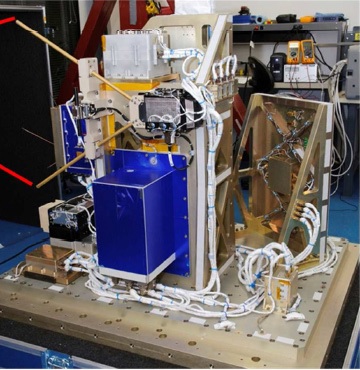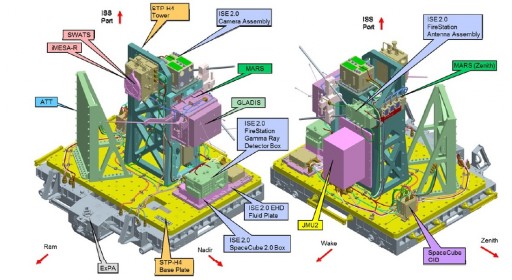Space Test Program – Houston-4

NASA’s Space Test Program is dedicated to fly small payloads loaded with different technical and other demonstrations to space for assessments in the space environment. A number of STP payloads have already been flown in the past including Department of Defense, university and NASA experiments. The STP-H4 payload will include eight experiments.
ATT or Active Thermal Tile is a series of variable conductance thermal interface tiles that is mounted on the STP payload featuring extensive sensor equipment to measure the on-orbit performance of these tiles as well as on-orbit degradation to get a measure for the lifetime of the different materials. Thermo-electric devices (TEDs) are used to modulate heat transfer between two interfaces such as a component and the spacecraft bus. Testing thermal control equipment in space provides engineers with data required to verify thermal models that are used. “The primary quantities of interest to be determined are the effective conductance in the high conductance cooling state, effective conductance in the low conductance state, and the coefficient of performance (COP) in the cooling and heating states,” a NASA statement said.
The ISE2.0 or ISS SpaceCube Experiment 2.0 will demonstrate the use of different computer processors in space to further assess the “radiation hardened by software” technology. “The goal of the SpaceCube program is to provide 10x to 100x improvements in on-board computing power while lowering relative power consumption and cost,” NASA’s experiment description said. Further improvements in Earth Science and Robotic Servicing applications developed by NASA Goddard and the Jet Propulsion Laboratory will also be made by demonstrating a gamma-ray detector to measure gamma-ray emissions from lightning on Earth. Data from that sensor will be used to demonstrate real-time on-board science data processing. The third section of the payload will demonstrate a Electro Hydro-Dynamic (EHD) thermal control system featuring a thermal plate with micro-channels for advanced thermal control.

STP-H4-FireStation is part of the ISE2.0 payload and measures the optical and radio wave emissions from lightning simultaneously with the gamma ray and energetic radiation produced during these events. The payload consists of a gamma ray / photometer system and a radio receiver system that measures the electric and magnetic field signatures of lightning.
ISE2.0 also includes a high-resolution camera that will provide data for processing by the processor system.
The GLADIS – Global Awareness Data-Exfiltration International Satellite is run by the Naval Research Laboratory, Washington. The payload features a dual channel Ultra High Frequency (UHF) and Very High Frequency (VHF) data-extraction payload that will be tested in orbit for use for Automatic Identification System (AIS) vessel tracking applications. The payload will also provide two way communications to widely distributed Maritime Domain Awareness sensor arrays via the Ocean Data Telemetry Microsat Link (ODTML). The main objective of the demonstration is to verify that these technologies can be used to built a small, light-weight and inexpensive satellite for global awareness purposes.
Miniature Array of Radiation Sensors, or MARS, will measure total dose radiation on a host spacecraft. In case of STP-H4, MARS is mounted in the vicinity of the GLADIS spacecraft demonstrator. Data provided by MARS provides data for 3D radiation modeling using an array of micro dosimeters sensors.
The SWATS or Small Wind and Temperature Spectrometer is a NASA payload that will demonstrate a low Size, Weight and Power (SWaP) space weather sensor. The payload will conduct simultaneous measurements of atmospheric density, composition, temperature and winds.
The IMESA-R payload is an Integrated Miniaturized Electrostatic Analyzer that will measure plasma densities and energies in the Magnetosphere and Ionosphere environment.
